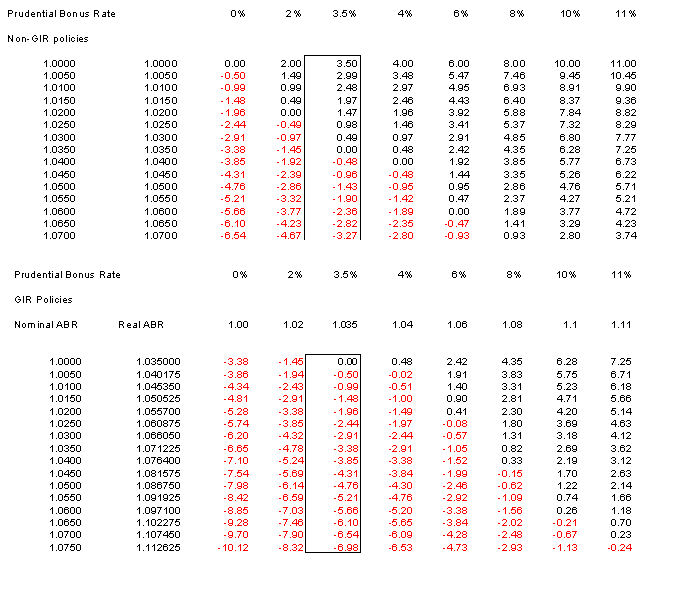|
|||||
|
THE PROPOSED TRANSFER TO THE PRUDENTIAL |
|||||
|
As
promised and now that we have more details, I am setting out a brief commentary
on my understanding of the proposed transfer of the Society’s With-Profits
Annuities to the Prudential. There
are certain points, which you may wish to consider before casting your vote on
the proposed deal. But it is important for you to bear in mind that your vote is
an entirely individual decision, as I cannot advise you how to vote nor would I
wish to do so. It is a decision you must make for yourself. However,
in order to assist you, I set out a short summary of my understanding. The
scheme is very complex and as a result, this is by necessity an
over-simplification to make it comprehensible. If you require further detail,
please look at the Equitable website and the further details available there and
of course seek professional advice. Summary
of the scheme 1.
The Annuitants will cease to be members and policyholders of the Society and
will instead become with-profits policyholders of Prudential. 2.
An amount, estimated initially to be of the order of £1.7 billion, will be
transferred to a separate sub-fund of Prudential and will be used exclusively to
provide the “unsmoothed component” of annuity payments. The intention is
that the sub-fund will be used exclusively for the benefit of Annuitants. This
sub-fund will be within the defined charges participating sub-fund. I refer to
this particular element of the defined charges participating sub-fund below as
“the DCPSF” (although technically there are, I understand, other elements of
the full sub-fund which will be kept separate). The
express intention is that the DCPSF will be used up over the future lifetime of
the portfolio of the Annuitants. The
DCSPF will have no liabilities other than the Equitable’s with-profits
annuities. The
investment risk and part of the mortality risk will be retained within the DCPSF
but all other risks will be undertaken by Prudential in return for payment made
by Equitable to Prudential. None of the risks nor any of the profits of
Prudential’s other business will fall upon the DCPSF. 3.
The transferred policyholders will have absolutely no recourse whatsoever to
Prudential’s inherited estate. The future annuity payments you will receive
will depend upon the performance of the DPCSF and there is no intention to
provide any subsidy or long-term support though there may be some short term
support for the smoothing process. 4.
The investment mix of the DPSCF’s supporting assets is intended to be the same
as for Prudential’s main with-profits fund which is approximately 50% in
equities, 30% in property and 20% in fixed interest investments. Over the long
term, most people would expect such an arrangement known as a “50/50” fund
to perform better than a fixed interest fund. However, in the shorter term,
there is an issue of timing given the cyclical nature of financial and property
markets. There
are, however, significant differences between Prudential’s main with-profits
fund and the DCPSF: i)
the main fund is supported by Prudential’s inherited estate whereas the
DCPSF has no inherited estate; ii)
the main fund is a continuing entity which is open to new business and
which can expect to receive further premiums in the future whereas the DCPSF is
closed to new business, will receive no further premiums and is contracting (as
the Annuitants die); iii)
the main fund represents policyholders who have paid and will continue to
pay premiums to Prudential at different times whereas all of the DCPSF will have
been paid to Prudential at the same time; and iv)
Prudential’s main with-profits fund will represent a constant or
increasing number of policyholders whereas the DCPSF will represent a declining
number of polices. Given
the differences set out above, an investment portfolio, that has been selected
to meet the needs of Prudential’s other with-profits policyholders, is
unlikely at all times to be the most suitable portfolio for the DCPSF. If,
in the event, the investment return that is credited to the DCPSF is both
positive and greater than that which might have been obtained from the
Society’s conservative investment policy, the Annuitants are likely to receive
future payments that are greater than they might otherwise have been and will
benefit from the Scheme becoming operative.
If, however, the returns are less than might have been obtained with the
Society, the new arrangements, although they might permit the impact to be
smoothed, will not create any additional funds that will fill the gap long term. Because
of Equitable’s weak solvency position, it was not able to take the risk of
matching liabilities with equity investments. The transfer to Prudential allows
that company’s stronger solvency to support such a position but I cannot
predict whether that would mean higher returns and it is only that which would
improve the annuitants’ position. Smoothing If
the scheme becomes operative, you will have the advantage of a clearly stated
smoothing policy including the safeguard of a with-profits committee (which is
required in non-mutual companies by the FSA). The Prudential’s stated
intention is to manage the overall rate of return within a range of 0% to 11%
per annum. Actual
Effect My understanding is that
payments will continue to be calculated on the same basis as before but of
course subject to the overall rates of return declared by Prudential within the
DCPSF. My experience is that the
average ABR for all annuitants is approximately 6.5% (having taken into account
real ABR’s – see below) with approximately two thirds of the policyholders
having ABR’s in the range 5.5 to 7.5%. GIR annuities were
typically sold before 1997 and for these annuities; the ABR was uplifted by
1.035. Thus an ABR of say 4.0% in practice becomes 1.04 x 1.035 or 1.0764 so
equates to a real ABR of 7.64%. As will be immediately obvious, the effect of
the multiplier of the uplift to the real ABR is that a much higher rate of
return is required to maintain payments. Non-GIR annuities were
typically sold after 1997 until close of business. In these policies, there is
no GIR uplift. The tables below show a
selection of results depending on the chosen (real) ABR and the overall rate of
return by the Prudential in any one year. The numbers in red indicate that the
annuity will decline in value and the actual number is the reduction in value as
a percentage of the previous year’s annuity payment. Conversely the numbers in
black indicate that the annuity will increase in value and the actual number is
the increase in value as a percentage of the previous year’s annuity payment.
The figures do not take into account the effect of any guaranteed elements in
the polcies that may exist. Given that the Prudential has to strip out its expenses and create a reserve for the "bad" years (the “smoothing” above), personally, I cannot see the Prudential paying out much above 4 or 5% over the next few years. Of course, I am not qualified to give advice on likely future returns and I do not attempt to do so. This is purely a personal view based on the stated proposed range of overall rates of return, the intention to “smooth” returns and the expenses required in administering the policies.
Combining
the spreadsheets and my experience of ABR’s (and real ABR’s) above suggests
to me that: a)
the overwhelming majority of annuitants will see their policy values
continue to fall in the immediate future; b)
even in the longer term it is difficult to envisage any GIR policy
increasing in value and the non-GIR policies will only achieve that when the
Prudential declares an overall rate of return in excess of in general 6.5%; c)
annuitants are likely to be better off remaining with the Equitable if
the Prudential declares overall rates of return in the region of 4% or lower as
this appears to be the "norm" for the Equitable (but conversely better
off with the Prudential if the overall rates of return are higher – see
below); and d)
annuities are likely to fall more slowly if the
Prudential declares overall rates of return in excess of 4% compared to staying
with the Equitable. Where
does this leave you? In
summary 1.
The future level of annuity payments will primarily depend upon the
returns secured by the investments backing the DCPSF. 2.
The assets are likely to include a significant proportion of equities
chosen with the interests of Prudential’s wider and continuing with-profits
portfolio. 3.
It is possible that the net proceeds of the investments backing the DCPSF
will be greater than might have been achieved from the Equitable’s more
restricted investment mix policy. 4.
However they may be less. What
is proposed is a transfer of the Society’s business model to a new home. The
rules are now expressed much more clearly and some of the risks have been
replaced by fixed charges. Nevertheless, the fund remains an uncapitalised
with-profits fund. The proposed transfer does not supply a new ingredient that
mitigates the risks or supplies additional funds. This opinion is very much in
line with that of the independent expert (Mr Sarjant) whose report you can read
in full on Equitable’s website. As
I mentioned at the beginning of this commentary, I cannot advise you on which
way to vote. In many ways this may boil down to a straight choice as to whether
in light of the position that you now find yourself (perhaps in contrast to the
position at the time of the original decision) you would like an annuity income
dependant upon a different investment mix than would be the case if the policies
remained with the Equitable. That again may be a matter, which turns upon your
own personal risk appetite, age etc as it is now given your current income needs
and personal circumstances. There
are two other factors you may wish to consider. The first is that if annuities
are transferred to the Prudential, you will be in a fund, which does not suffer
the risk of any further mis-selling liabilities that may fall upon Equitable.
The second is that nobody can predict whether the Parliamentary Ombudsman will
press for compensation and even if it did, whether this would be to individuals
or into Equitable’s with-profits fund. Personally, I consider the latter
unlikely. I
will not take questions on the contents of this bulletin as I have solely put
this information on the ELTA website partly because I made that commitment and
partly because members have asked help. Peter
Scawen 17 October 2007 |
|
||||

